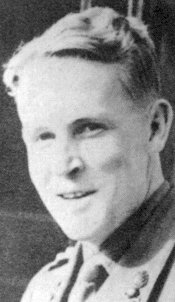Patrick Anthony Porteous
Patrick Anthony Porteous | |
|---|---|
 | |
| Born | 1 January 1918 Abbottabad, British India |
| Died | 9 October 2000 (aged 82) Funtington, West Sussex |
| Buried | St Mary's Churchyard, Funtington |
| Allegiance | |
| Service | |
| Years of service | 1937−1970 |
| Rank | Colonel |
| Service number | 73033 |
| Unit | Royal Artillery No. 4 Commando |
| Battles / wars | World War II |
| Awards | Victoria Cross |
Colonel Patrick Anthony Porteous VC (1 January 1918 – 9 October 2000) was a Scottish recipient of the Victoria Cross, the highest and most prestigious award for gallantry in the face of the enemy that can be awarded to British and Commonwealth forces.
Second World War
Porteous was commissioned in the Royal Regiment of Artillery in 1937.[1] On 26 August 1940 he was promoted to lieutenant.[2] On 19 August 1942, he was 24 years old and a temporary major[3] attached to No. 4 Commando when he did the deed for which he was awarded the VC, during the Dieppe Raid. The citation was published in a supplement to The London Gazette of 2 October 1942 and read:[4]
War Office, 2nd October 1942.
The KING has been graciously pleased to approve the award of The VICTORIA CROSS to: —
Captain (temporary Major) Patrick Anthony Porteous (73033), Royal Regiment of Artillery (Fleet, Hants.).
At Dieppe on the 19th August 1942, Major Porteous was detailed to act as Liaison Officer between the two detachments whose task was to assault the heavy coast defence guns.
In the initial assault Major Porteous, working with the smaller of the two detachments, was shot at close range through the hand, the bullet passing through his palm and entering his upper arm. Undaunted, Major Porteous closed with his assailant, succeeded in disarming him and killed him with his own bayonet thereby saving the life of a British Sergeant on whom the German had turned his aim.
In the meantime the larger detachment was held up, and the officer leading this detachment was killed and the Troop Sergeant-Major fell seriously wounded. Almost immediately afterwards the only other officer of the detachment was also killed.
Major Porteous, without hesitation and in the face of a withering fire, dashed across the open ground to take over the command of this detachment. Rallying them, he led them in a charge which carried the German position at the point of the bayonet, and was severely wounded for the second time. Though shot through the thigh he continued to the final objective where he eventually collapsed from loss of blood after the last of the guns had been destroyed.
Major Porteous's most gallant conduct, his brilliant leadership and tenacious devotion to a duty which was supplementary to the role originally assigned to him, was an inspiration to the whole detachment.
Later career
In spite of severe wounds, Porteous went on to make a full recovery and had a distinguished military career in Palestine, Germany and Singapore. Following the war he was confirmed in the rank of captain,[5] promoted to major in 1950,[6] lieutenant colonel on 1 May 1959,[7] and rose to the rank of colonel before he retired in 1970.[8] He had the honour of being in the leading car at the late Queen Mother's 100th Birthday Parade, before his death in October 2000, aged 82.[citation needed]
References
- ^ Obituary
- ^ "No. 34931". The London Gazette (Supplement). 23 August 1940. p. 5204.
- ^ "No. 35730". The London Gazette (Supplement). 2 October 1942. p. 4339.
- ^ "No. 35729". The London Gazette (Supplement). 2 October 1942. p. 4323.
- ^ "No. 37239". The London Gazette (Supplement). 24 August 1945. p. 4319.
- ^ "No. 39003". The London Gazette (Supplement). 29 August 1950. p. 4367.
- ^ "No. 41884". The London Gazette (Supplement). 1 December 1959. p. 7669.
- ^ "No. 45078". The London Gazette (Supplement). 10 April 1970. p. 4173.
Further reading
- British VCs of World War 2 (John Laffin, 1997)
- Monuments to Courage (David Harvey, 1999)
- The Register of the Victoria Cross (This England, 1997)
- [citation needed]"Patrick". Archived from the original on 9 January 2016. Retrieved 9 September 2011.
